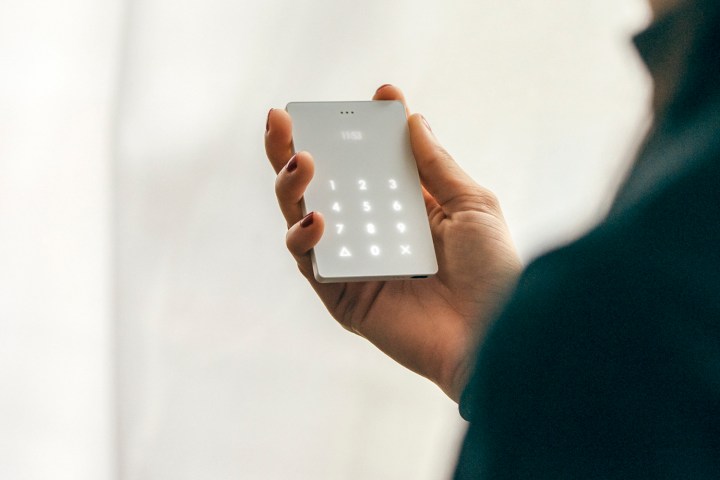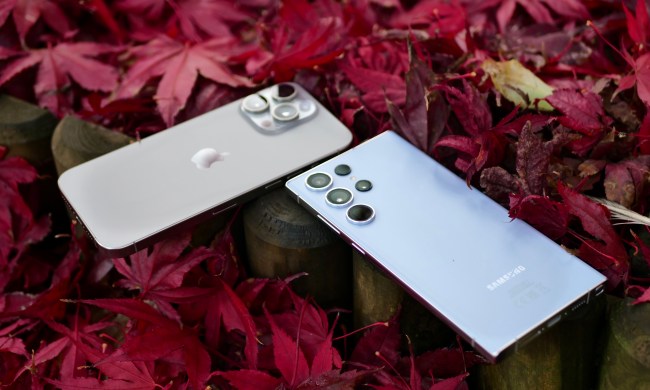
The Light Phone is many things. It’s a second phone, designed to complement, rather than replace, your smartphone. It’s the size of a credit card, a nondescript slab of plastic with no discernible face, until its turned on. And it’s the only mobile phone in recent memory explicitly designed not to be used.
It’s a product best described in terms of what it can’t do, rather than what it can. The Light Phone doesn’t have a traditional “screen” — just a basic LED readout wide enough to show a number. It cannot send or receive text messages or emails, let alone snaps or tweets. Speaking of which, there’s no camera, nor are there any apps. It’s just a phone with nine slots for speed dials.
The goal is freeing yourself from smartphone addiction, during those times when its most necessary. Light’s founders, Joe Hollier and Kaiwei Tang, have no presumptions their device could be your one-and-only; in fact, they explicitly discourage using the phone in that way. The philosophy is based around mindfulness, and not letting your attention on a hike or an outing with friends be stolen by the pressure of constant connectivity and a barrage of information. It’s an ethos they’ve appropriately termed “going light.”
“There’s this huge initial anxiety every time you go light” Hollier told Digital Trends. “You find yourself tapping your pockets, and you feel, dare I say, physically different — like you have a different air about yourself.”
It’s a product best described in terms of what it can’t do, rather than what it can.
Hollier says having that direct line of communication to everything and everyone always available affects us more than we realize.
“The value is not in the phone itself, but in that sort of jarring initial feeling. But it also sort of always transitions into this very relieving and relaxing place once you’re able to cross the wall of FOMO.”
Light launched its first crowdfunding effort on Kickstarter roughly two years ago. Since then, it has sold just shy of 10,000 phones all around the world — though there was some trepidation early on.
“We got very polarizing reactions [back in 2014]. We still get very polarizing reactions … A lot of the people we would pitch to come back in three months and six months, and even just in that experience with us, we’ve watched their opinion change.”
It’s not surprising that the public would be warming up to the idea. Never before have there been as many articles, books, and research studies written on the relentless pressure to stay connected. The stress can be as debilitating as it is addictive. Sometimes we love our phones, sometimes we deliberately ignore them, but its dreadful to imagine going through an entire day without them.
A potential solution is to grab that old feature phone collecting dust in your drawer for those special occasions. But as carriers start scaling back their old 2G networks in favor of LTE and the next frontier of 5G, it’s quite possible your ancient Nokia or Motorola might wake up to a very different network than the one it left. We haven’t even touched on the struggle of maintaining your current number.
As remarkable as the Light Phone is for its lack of functionality, a surprising amount of work has been poured into making it a snap to carry around in your pocket in lieu of your smartphone. Hollier and Tang knew they’d have to make it a cinch to simply grab and go, rather than forcing users to fiddle with call forwarding settings, SIM cards, and the like.
To that end, they developed a cloud software platform to handle call routing. The Light Phone runs a simplified version of Android, so it’s uniquely able to handle some of the logistical work in tandem with the system the startup has developed.
If you live in the U.S., the Light Phone ships with its own SIM card, but can adopt the number of your primary phone. The SIM comes with a charge of $5 per month. For overseas customers, the process is not quite so seamless — the device arrives more or less as a typical unlocked phone, with no SIM card. That means users are required to purchase their own service, or perhaps buy a duplicate SIM if it’s allowed in their region.
As remarkable as it is for its lack of functionality, a surprising amount of work has been poured into making it a snap to carry around
But there’s the unavoidable issue of price. The Light Phone currently runs $150. The company has justified the cost, in part, as a way of slowing the pace of consumption and lessening the financial and physical toll it takes on the thousands of people along the production line. Virtuous as that may be, there’s no getting around the fact $150 is a lot to spend in this day and age on a phone that does so little, especially when devices like the Moto E4 offer practically everything for $130.
That’s not an argument steeped in a mindless desire for bells and whistles; on a limited budget, when you’re simply looking to get the most capable, useful handset for your hard-earned dollars, the Light Phone becomes a very difficult expense to explain.
But then you can’t really call what Light has made just another mobile phone. Nothing else comes close, in design, function, or purpose. Just about everyone who comes in contact with one knows it.
“It sort of seems like you’re selling this glorified Pet Rock,” Hollier says of most users’ general reaction. “But it’s a very powerful experience.”




